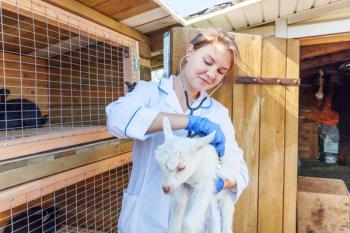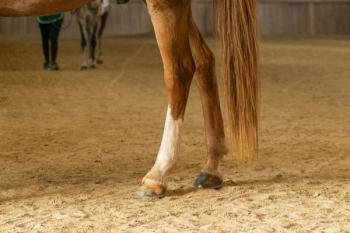
- dvm360 June 2019
- Volume 50
- Issue 6
Racing surface at Santa Anita likely contributed to 25 equine deaths
Catastrophic injuries peaked in late February and March 2019; veterinarians point to multiple factors, call for further investigation.
On Feb. 23, Battle of Midway, a prominent 4-year-old thoroughbred racehorse, severely shattered his hind pastern during a training exercise at Santa Anita Park in Arcadia, California, and had to be euthanized. On that same day another equine athlete also suffered a catastrophic injury, and on Feb. 25 a third horse in three days had to be put down. This was the peak of a wave of catastrophic injuries at Santa Anita beginning in late December 2018 that would reach 25 total by late May-a sharp increase from previous years.
When the fatalities reached their peak, the California Horse Racing Board and Santa Anita Park management announced their decision to close the track for evaluation. Mick Peterson, director of the University of Kentucky's Agricultural Equine Programs and an analyst for Santa Anita track soil, was brought in to evaluate the racing surface and attempt to resolve the issues leading to horse injuries during training and racing.
Peterson noted that heavy winter rains had led to track “segregation,” a process in which fine material in the top surface cushion moves to the inside rail as water washes across the track surface. He issued a call for ground-penetrating radar tests and further analysis. “We have two responsibilities,” Peterson stated, “to find out what happened and to fix it so it does not happen again.”
Scrutiny of the surface-and below the surface
The Stronach Group, owners of Santa Anita Park, issued a statement in early March acknowledging the track's altered composition due to heavy rains over the winter. “I honestly don't think there's a problem, but weather has been a factor,” said COO Tim Ritvo. He admitted that the track had been floated and sealed a lot, “so that it's tighter than it has been.”
The ownership group brought in Racing Services Testing Lab (RSTL)-an organization that analyzes, maintains and enhances racing surfaces for consistency and safety-for additional work on the track at Santa Anita. In addition, they announced that several new safety and welfare measures would be put in place. Going forward, Santa Anita would require trainers to apply for permission from a veterinarian to work a horse at least 24 hours in advance. This would allow time to review each horse's racing and training history and, if necessary, physically examine horses before their workouts. Additionally, each horse would be observed going to and from the racetrack by a team of two track veterinarians.
“This will allow track veterinarians to assist in identifying ‘at risk' horses,” Ritvo said. “Santa Anita has hired additional veterinarians to observe all horses entering and exiting the tracks each morning during training hours.”
By March 11, the owners and track analysts were ready to reopen Santa Anita's main track for limited training. “We've been able to do a great deal in terms of amending the soil and inspecting it,” said RSTL's Dennis Moore, head of the team investigating the track. “The most important thing is that we closely monitor compaction levels. With all the rain-and this is the case in any wet winter-the ‘fines'-silt and sand-can change very quickly and that affects the clays as well. Compaction as well as dilution of silt and sand are all factors in the overall composition of the soil.”
Dennis Moore, a racetrack surface expert with the Racing Surface Testing Lab, takes racing surface measurements at Santa Anita Park. Photo courtesy of Mike Willman, Santa Anita Park.Despite the work that had been done, yet another horse broke down on March 14 during a training session at Santa Anita and had to be euthanized. This was the 22nd fatality of the season.
Race-day medication reforms
The next day, the Stronach Group announced that it was taking “the unprecedented step of declaring a zero tolerance for race-day medication” at Santa Anita, along with its Golden Gate Fields race course in San Francisco. These thoroughbred courses would be the first in North America to follow the strict International Federation of Horseracing Authorities standards
“We have arrived at a watershed moment,” the owners announced. “The Stronach Group has long been a strong advocate for the abolishment of race-day medication, but we will wait no longer for the industry to come together as one to institute these changes. Nor will we wait for the legislation required to undertake this paradigm shift. We are taking a stand and fully recognize just how disruptive this might be.”
The new policy completely revised previous medication rules “to improve the safety of our equine and human athletes and to raise the integrity of our sport,” the announcement continued. It called for:
- Banning the use of furosemide.
- Increasing the ban on legal therapeutic NSAIDs, joint injections, shockwave therapy and anabolic steroids.
- Complete transparency of all veterinary records.
- Significantly increasing out-of-competition testing.
- Increasing the time required for horses to be on site prior to a race.
- An investment in new diagnostic equipment to aid in the early detection of pre-existing conditions.
- Allowing the use of therapeutic medication only with a qualified veterinary diagnosis.
These changes would be in addition to the owners' continued commitment to engage outside experts to review dirt, turf and synthetic courses, they said.
The veterinary perspective
Equine veterinarians are voicing their concern in response to the high number of catastrophic injuries this season at Santa Anita.
“The rain and its effect on the track surface is likely a factor,” says Susan Stover, DVM, PhD, DACVS, a professor at the University of California, Davis, School of Veterinary Medicine. “But other factors are also probably playing a role here. One is the frequency and intensity of racing and training. When the level of exercise is too high, the skeleton does not have time to recover and strengthen from the previous training or racing event. The skeleton becomes transiently weaker and susceptible to mild injury. If affected horses continue to train and race before a mild injury has had time to resolve, they are highly susceptible to a catastrophic injury, particularly if another factor, like an unfavorable racing or training surface, adds abnormal loads to the skeleton.”
Consequently, Dr. Stover notes, “the racehorse inventory needed to support the racing schedules of the racetracks needs to be examined. Horses must be trained and raced at a level at which they can maintain musculoskeletal health. If too few horses are trained and raced at a high frequency to meet the needs of the race schedule, those horses will be at higher risk for injury.”
While the rain and its effect on the racetrack surface has clearly been an issue, Dr. Stover says, “I'm not sure if you started out with completely healthy horses that the horses would have been injured.”
Jeff Blea, DVM, of Von Bleucher, Blea, Hunkin, wants to see some data from the recent round of catastrophic injuries. “Twenty-two horse deaths are disgusting in this short period of time,” he says. “There are a lot of data points that need to be reviewed, such as necropsy findings-every horse that suffers a catastrophic breakdown in California undergoes a necropsy. The data from those necropsies will be essential to help determine what has occurred, specifically to see if there were any pre-existing problems or commonalities.”
It remains to be seen whether the reforms that have been instituted will have an effect, Dr. Blea continues, along with what changes still need to be implemented. “We need to determine what needs to be done-from a practitioners' standpoint, a horseman's standpoint and from the management standpoint,” he says. “Although they've issued a mandate for no race-day medication (i.e. Lasix), I'm not sure that will make any difference as to what has occurred regarding these recent catastrophic breakdowns. I really don't think medication or lack thereof can take the blame for this.”
The racing surface analysts also have their work cut out for them, he says: “It's a daily thing. Adjustments and testing are going to take place for a while, possibly several weeks, especially when the weather changes. You have to make sure the racing surface is consistent rail to rail.
“Regardless of what occurs over the next several weeks or more, I believe a lot of work will have to continue to be done to get Santa Anita Park back to ‘normal' to get this situation fully resolved,” Dr. Blea says. “I don't think we're out of woods!”
Epilogue
Dr. Blea's words turned out to be portentous. On March 31, a gelding named Arms Runner suffered a fatal injury at Santa Anita just three days after the park reopened for racing. The track remained open, however, and the Santa Anita Derby passed without incident on April 6. But two more horses were fatally injured in mid-May, bringing the season's death toll to 25.
The horse racing industry, regulatory organizations, animal welfare groups and veterinarians remain on high alert. Whether Santa Anita continues to be “The Great Race Place,” as it bills itself, remains to be seen-along with the sport's continued survival in the face of concerns over equine safety.
Ed Kane, PhD, is a researcher and consultant in animal nutrition. He is an author and editor on nutrition, physiology and veterinary medicine with a background in horses, pets and livestock. Kane is based in Seattle.
Articles in this issue
over 6 years ago
Voting for 2019 American Humane Hero Award now openover 6 years ago
A veterinary hospital to be seen inover 6 years ago
Checklist: Better communication as a veterinarianover 6 years ago
Updates and appointment reminders? Text, please!over 6 years ago
Walmart expanding walk-in pet clinic and pet pharmacy offeringsover 6 years ago
Letter to dvm360: Should non-DVMs 'fire' veterinary clients?over 6 years ago
UC Davis study: Homemade feline diets nutritionally inadequateover 6 years ago
Hope or hoax? How to evaluate veterinary cancer therapiesover 6 years ago
Shelter Snapshot: 9 ways to up your spay/neuter gameNewsletter
From exam room tips to practice management insights, get trusted veterinary news delivered straight to your inbox—subscribe to dvm360.




